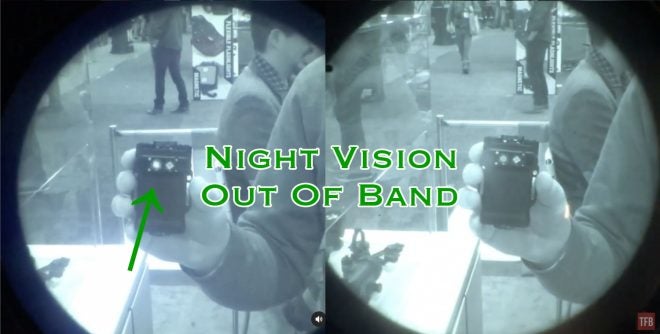Welcome back fellow night vision enthusiasts to another installment of Friday Night Lights brought to you by ATN Corp, manufacturers of night vision and thermal optics like the THOR LT. As with all of our sponsored series, Friday Night Lights will continue to bring you unbiased news and reviews from a variety of companies. Today we will take a look at something called OOB (out of band) with regards to night vision. It is fact or fiction?
OOB @TFB:
- [SHOT 2020] Friday Night Lights Shot Show 2020 NVG Round Up
- SWIR MAWL-CLAD – Now Even More Invisible IR Laser
- Friday Night Lights: Northrop Grumman MARK VII – 10km Day/Night Vision LRF
What Is OOB?

“Out of band” or OOB refers to the infrared spectrum and specifically taking advantage of wavelengths that traditional analog night vision cannot see. Take a look at the wavelength spectrum. Analog night vision amplifies light between 600 nm to 930 nm. This includes some visible light and up into the infrared spectrum however it is small compared to other types like SWIR, MWIR and LWIR.
Why is OOB important? Peer forces. Enemies possessing night vision. This makes using infrared laser and illuminators dangerous. You no longer own the night if your enemies can see you shining light out of your gun. So what can one do to combat this problem? Take advantage of other wavelengths beyond night vision’s ability to see. Photonis claims their image intensifiers can see higher wavelengths.
Photonis claims:
Photonis 4G tubes deliver a bandwidth from below 400nm to above 1,000nm.
At SHOT Show 2020, Photonis had a little demo to show how their image intensifiers can see a wider wavelength range than traditional Gen 3 gallium arsenide image intensifiers like L3 or Elbit tubes. They had a binocular setup where one pod had a Photonis tube and the other pod had a Gen 3 tube. Watch the video below. There is no audio but you can see the Steiner Nova beacon flash when looking through the Photonis side but you cannot see it with the Gen 3 tube.
Recently I got a chance to check out an OOB laser. It is a Somogear NGAL that was made using 980nM laser diode. It was very dim when looking through Gen 3 night vision. Even at full power, it was a struggle to see it 200 yards away. Photonis tubes performed a little bit better but what really shows the capabilities of this laser was when I used my SiOnyx Aurora Pro to look at the laser. It was bright and clear. Just like a regular full-power IR laser, you can see a solid beam. I did not see a solid beam with either Gen 3 or Photonis. See the video below.
Here is the same laser on a different night but looking through an old Gen 3 image intensifier as well as a Photonis image intensifier. While not a bright as the SiOnyx Aurora, the laser could be seen at further distances with the Photonis tube than the Gen 3 tube.
A couple years ago I had a gun engraved with a fiber laser. I tested night vision’s ability to see this laser since fiber lasers operate at 1064nM. While I could see the bright spot that the laser hit, I could not see the beam with either Gen 3 night vision or with Photonis tubes. Digital night vision can see a wider range of wavelengths than analog Gen 3 night vision. Similar to Photonis, the Aurora can see 400 to 1100nm according to SiOnyx. I was able to see the laser beam with my old SiOnyx Aurora but only just barely. The fiber laser is built by Lit Laser and they list the laser power at 20W. That is a lot more powerful than your run-of-the-mill 40mW full-power firearm lasers. Usually the higher power of the laser, the easier it is to see. Not the case with the fiber laser. Only when it evaporated metal and the particulates wafted into the path of the laser could I see the beam with the Aurora. See the video below.
What does this mean? 980nM lasers seem obtainable but trying to find a higher wavelength laser in the 1064nM range is a tall order, especially something portable and low powered enough.
SWIR OOB Options
The military is allegedly using SWIR, short wave IR to combat peer forces. Just like how your naked eyes cannot see infrared but analog night vision can, night vision cannot see SWIR. It is a higher wavelength. SWIR imaging sensors can see through smoke and fog as well as tinted glass. Here is a video by Brolis Defense.
In order to view SWIR, you need a SWIR capable sensor. You can augment analog night vision with a clip-on SWIR imager or COSI by Optics1. Like a COTI, the COSI attaches to the objective lens of your night vision device.

Optics 1 COSI with viewfinder attached.
The Brolis SWIR solution is a clip-on device for a long gun that mounts in front of a day optic. There are SWIR lasers like the MAWL-CLAD for traditional aiming with a carbine.


Since analog night vision cannot see SWIR, this is one way to combat peer forces with night vision. Some SWIR does leak into the lower wavelengths and can be seen with a digital sensor. I tested a Steiner Helmet Mounted Beacon that has a SWIR emitter and filmed through Gen 3 night vision as well as a SiOnyx Aurora.
Thermal Is OOB
The problem with SWIR is that it is very niche. The cost of the sensors is rather expensive. The technology has not been mass produced nor developed nearly as much as the thermal imaging market. It is easier and cheaper to get a decent thermal imaging device for under $2,000. Certain thermal devices like the cooled thermal systems are very sensitive and some can see through smoke and fog. However, there are some drawbacks to thermal. Thermal radiation does not penetrate glass. So you cannot see through windows like you can with regular IR night vision and SWIR. As far as I know, there are no thermal lasers to aim with. Either you aim with a dedicated thermal weapon sight or you wear a thermal monocular over one eye and aim passively with your unaided eye.
With respect to thermal, there are two types, cooled and un-cooled. Cooled thermal has higher sensitivity than uncooled. I have a strange Wilcox handheld device. It can be seen with IR but it also emits a signature that can be viewed by thermal, however, it is very weak looking under an uncooled thermal device. It gets overpowered by body heat and I cannot see it very far under normal thermal imagers. I got to try it with my friend’s FLIR HISS which is a cooled thermal sensor and we could see it 300 yards away.
In the video above you saw a Steiner Nova Beacon that has a thermal emitter. Similar to the Wilcox device, the thermal emitters are rather weak looking under uncooled thermal imagers. But when looking at them with a cooled thermal, you can see the beacon from hundreds of yards away.
Is OOB Right For You?
Out of band sounds great. You can use a laser like the Somogear airsoft replica. However, there are not really any other options at the moment. They just don’t make them with that specific wavelength diode.
OOB only helps when using a laser against an enemy who has night vision. This is a concern for the military and possibly law enforcement. With the onset of digital sensors, it is easy to modify a digital camera sensor to be able to see infrared. It won’t amplify light but it can see infrared.
The best and easiest way to combat peer forces is to use light and laser discipline. Or aim passively that way you do not emit any light or laser that can give away your position.
 Your Privacy Choices
Your Privacy Choices

